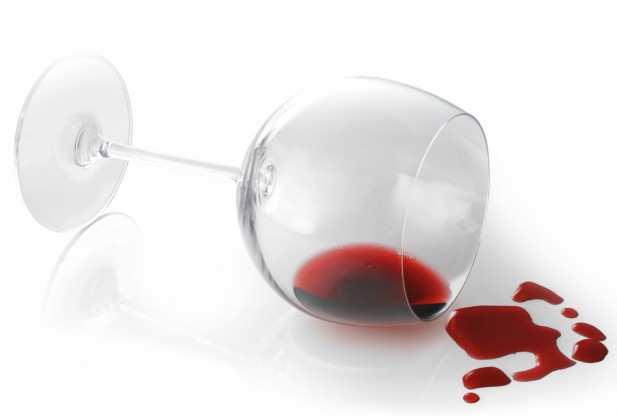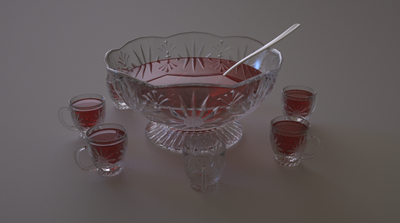Page 3 of 6
Re: The problem of interfacing liquid and glass.
Posted: Tue Dec 11, 2012 9:43 am
by truerender
Karba not be a heretic of physics!
Repair the engine, think of something.
I do not want to organize dances with a tambourine and make the water IOR = 1 and other machinations.
I want the performance of rendering.
air IOR = 1
water IOR = 1,33
glass IOR = 1,55
And so on!
Repair! Repair! Repair!
Re: The problem of interfacing liquid and glass.
Posted: Tue Dec 11, 2012 9:51 am
by vk3d
Karba, can you try to do a bootle with liquid without color?.. like water or vodka. There you can see more mistakes or else..
Re: The problem of interfacing liquid and glass.
Posted: Tue Dec 11, 2012 11:05 am
by temp-64GTX
Karba wrote:That is correct way.
glass has 1.3 ior
liquid has 1.3 ior
So from glass to liquid there is no ior difference.
So ior between glass and liquid is 1.0 or close to 1.0.
Render engine is correct.
Глупости. What happens if I want to look at the cup top? Your water with IOR=1.0 will be in the direct line of sight.
Re: The problem of interfacing liquid and glass.
Posted: Tue Dec 11, 2012 11:15 am
by bicket
truerender wrote:Karba not be a heretic of physics!
Repair the engine, think of something.
I do not want to organize dances with a tambourine and make the water IOR = 1 and other machinations.
I want the performance of rendering.
air IOR = 1
water IOR = 1,33
glass IOR = 1,55
And so on!
Repair! Repair! Repair!
Truerender is right, ior is constant for a given material (at constant temp and pressure...) and doesn't dépend on where you come from (air, glass or whatever).
Octave should detect that the ray is leaving the glass (direction id the ray is the same as the normal) and is entering in the liquid. That the only physicaly correct way to go.
With your method (1.5/1.3=ior) the liquid will not have the same ior in a crystal glas and in a plastic bottle. No sens !
The liquid has its own ior.
Re: The problem of interfacing liquid and glass.
Posted: Tue Dec 11, 2012 4:54 pm
by Proupin
What about an automatic way for very close, opposing normal surfaces, the surfaces facing away from camera getting clipped out. There is currently no threshold whenever two opposing surfaces are very close, and apparently that creates the darkness etc, at least it appears. Whatever the approach, other renderers have solved this issue, I know Maxwell's forums have extensive discussions on this stuff, so the info is out there for sure. Vray suggests the overlap method, but it states that "the renderer must keep track of which surfaces have been intersected along a ray path, so that it can compute the correct index of refraction."
here
Re: The problem of interfacing liquid and glass.
Posted: Tue Dec 11, 2012 7:29 pm
by truerender
What about an automatic way for very close, opposing normal surfaces, the surfaces facing away from camera getting clipped out. There is currently no threshold whenever two opposing surfaces are very close, and apparently that creates the darkness etc, at least it appears. Whatever the approach, other renderers have solved this issue, I know Maxwell's forums have extensive discussions on this stuff, so the info is out there for sure. Vray suggests the overlap method, but it states that "the renderer must keep track of which surfaces have been intersected along a ray path, so that it can compute the correct index of refraction." here
Do you see picture on the 1-t page of the topic? The problem is that it is not good method to for now. For me and for physics correction.
Re: The problem of interfacing liquid and glass.
Posted: Tue Dec 11, 2012 10:56 pm
by Karba
Seem we just don't understand each other
here is a scene with render and reference

Re: The problem of interfacing liquid and glass.
Posted: Wed Dec 12, 2012 1:59 am
by Proupin
this Maxwell method doesn't work at all for animations!
truerender, what I don't see clear in the image is if 1+2 is the slight overlap method or there's a small gap between container and liquid. It looks like the latter.
Doing some tests I noticed something: the attached image shows the overlap method where the liquid has absorption (the slanted rectangle has the same material). Notice how in the overlap areas the material loses all it's absorption properties!! whereas from above it looks correct...
The second image shows the 'liquid enclosed with a slight gap' method. The material looks alright, but refractions are not ok.
I insist on the overlap method over the maxwell method because of animation.
Re: The problem of interfacing liquid and glass.
Posted: Wed Dec 12, 2012 3:42 am
by Tugpsx
Not up to your level, but where is there an IOR setting on the stand alone version.

- Punch Bowl test
IOR List
http://forums.cgsociety.org/archive/ind ... 13458.html
Re: The problem of interfacing liquid and glass.
Posted: Wed Dec 12, 2012 5:54 am
by truerender
this Maxwell method doesn't work at all for animations!
truerender, what I don't see clear in the image is if 1+2 is the slight overlap method or there's a small gap between container and liquid. It looks like the latter.
Doing some tests I noticed something: the attached image shows the overlap method where the liquid has absorption (the slanted rectangle has the same material). Notice how in the overlap areas the material loses all it's absorption properties!! whereas from above it looks correct...
The second image shows the 'liquid enclosed with a slight gap' method. The material looks alright, but refractions are not ok.
I insist on the overlap method over the maxwell method because of animation.
In method 1 +2 have the intersection (overlap). So we are making the stick liquid the glass.
Other if we have a small gap that will be all right - but it's just two items are inserted into each other, but not the liquid adhered to the glass!
Animation is about the second question. I honestly do not care as long as it.
In your test, you can see for yourself.
Once you have very dark liquid.
